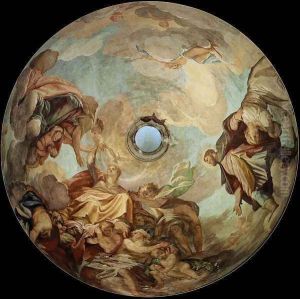Girolamo Pellegrini Paintings
Girolamo Pellegrini was an Italian painter of the late Baroque period, active mainly in his native Bologna and in Venice. Born in 1674 in Bologna, Pellegrini was part of a family that was deeply involved in the arts. His father, Antonio Pellegrini, was a decorative painter, which provided the young Girolamo with an artistic environment from an early age.
Girolamo Pellegrini’s training began under the guidance of his father and later, he was a pupil of the renowned Bolognese painter, Carlo Cignani. Cignani’s influence is evident in Pellegrini’s early work, particularly in the softness of his figures and the delicate treatment of his subjects. After completing his apprenticeship, Pellegrini ventured to Venice, which was a significant center for the arts and offered ample opportunities for a young and ambitious painter such as himself.
In Venice, Pellegrini became associated with the Venetian school of painting, which was known for its vibrant color and emphasis on light. During this time, he also came into contact with other prominent painters, including Sebastiano Ricci, whose style further influenced Pellegrini’s development as an artist. His work from this period demonstrates a fusion of the Bolognese style, characterized by its academic rigor and soft forms, with the more luminous and expressive approach of the Venetian school.
Pellegrini’s oeuvre consists mainly of religious and mythological themes, often characterized by dynamic compositions and a dramatic use of light and shadow. He also painted portraits and was involved in decorative projects in various churches and palaces, where his frescoes and altarpieces can still be admired.
Throughout his career, Pellegrini enjoyed the patronage of several high-ranking individuals and religious institutions, which helped him secure commissions and bolster his reputation. However, despite his success, Girolamo Pellegrini has not been as widely recognized as some of his contemporaries, and much of his life and work remain less documented.
Girolamo Pellegrini passed away in 1745 in Venice. His legacy is preserved in his contributions to various Italian churches and collections where his works are held, reflecting the interplay of Bolognese classicism and Venetian colorism that characterized the art of his time.
